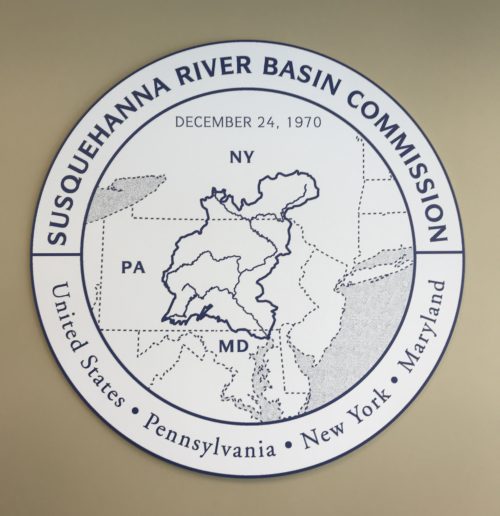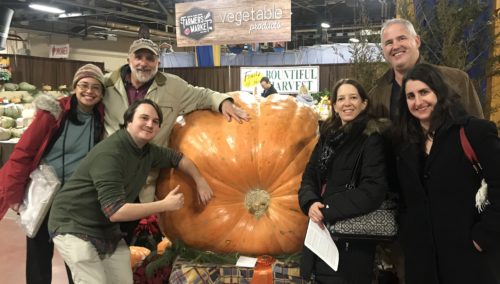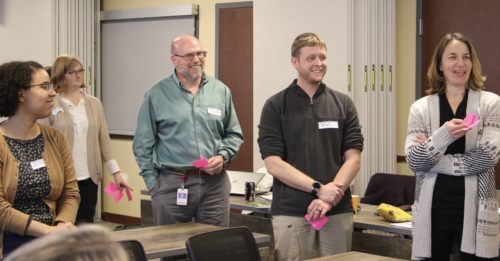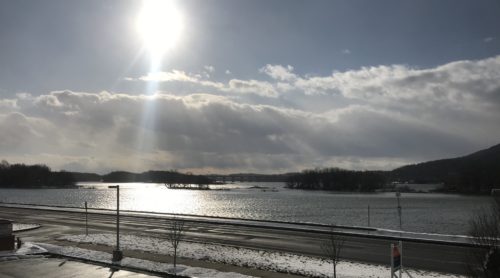Developing a Chesapeake Watershed report card: Harrisburg PA workshop
Bill Dennison ·

On 7-8 Jan 2020, several IAN staff traveled to Harrisburg, Pennsylvania to facilitate a workshop with scientists and resource managers to discuss the development of a Chesapeake Watershed report card. This report card will not replace the annual UMCES Chesapeake Bay report card, but will expand its scope both geographically (to include the entire watershed) and conceptually (to include socio-economic indicators). This effort is being supported by the National Fish & Wildlife Foundation. Bill Dennison, Caroline Donovan, Alex Fries, Vanessa Vargas-Nguyen and Sky Swanson from UMCES staffed the workshop, which was held at the wonderful headquarters of the Susquehanna River Basin Commission (SRBC) overlooking the Susquehanna River.

We chose to have the workshop during the Penn Farm Show, which was an amazing event. We had our dinners at the Farm Show, and wandered around to see incredible animals, taste the locally produced wines and cider, view farm equipment, cheer on horse races, and stood in awe of the giant butter sculpture.

At the beginning of the workshop, we had a few presentations to set the scene. I reviewed the development of report cards and how they inform environmental intelligence. Gary Walters from Pennsylvania Department of Environmental Protection (DEP) provided a great historical overview. I was impressed with the long and rich history of Susquehanna River watershed monitoring that had occurred. Gary also provided some insights into the legacy of the ‘industrial landscape’ of rural Pennsylvania, particularly mining that has affected the watershed. Dustin Shull, also from DEP, walked us through the website that he has been putting together, in which Pennsylvania water quality data for state waterways is made available with high resolution maps. Claire Buchanan from the Interstate Potomac River Basin Commission (IPRBC) presented the latest update of the integrated benthic macroinvertebrate monitoring data that she and her team have assembled across the entire Chesapeake Bay watershed. At one point, Claire from IPBRC and Jeremy Hoffman from SRBC were standing next to one another and I realized that through their respective organizations, these two people represented three quarters of the massive Chesapeake Bay watershed. Both Alex Fries and Vanessa Vargas-Nguyen from IAN made short presentations about potential watershed indicators, which resulted in a productive discussion about appropriate indicators. We ended the first day with a round of SNAP!, in which the values and threats to the watershed were identified.

Photo Credit: Sky Swanson
On day two of the workshop, we reconvened to do a mapping
exercise to identify potential reporting regions across the Chesapeake Watershed.
We also drafted a wheel of potential indicators and nominated data sources for
each wedge. We mocked up a report card layout through a storyboarding exercise
and finally, we discussed next steps to close out the workshop. It was snowing
on both days, and it was fun to watch the snow squalls over the Susquehanna
River outside our workshop windows.

Photo Credit: Bill Dennison
Nick DiPasquale, former Chesapeake Bay Program Director, came along in his role as science advisor to ShoreRivers, an Eastern Shore of Maryland NGO. It was great to see Nick again. We also had some key folks from Pennsylvania (e.g., Kristen Wolf), Maryland (e.g., Bruce Michael) and Virginia (e.g., James Martin), and SeaGrant extension agents from both Pennsylvania and Maryland. Ann Swanson and Marel King from the Chesapeake Bay Commission provided great input as well. All in all, we had an enjoyable and productive time together.
To conclude our workshop, I sang a song, adapted from Canned Heat about ‘Going up the Country’. Attending the Farm Show and discussing watershed issues conjured up memories of Canned Heat’s number that they played at Woodstock. The lyrics for my version of ‘Going up the Country’ are as follows:
Going up the Country
8 Jan 2020
William C. Dennison
I’m going up the country, baby, don’t you want to go?
I’m going up the country, baby, don’t you want to go?
I’m going to the Farm Show where I’ve never been before
I’m going, I’m going where the water tastes like wine
I’m going where the water tastes like wine
We can make a report card, and not argue all the time
I’m gonna leave the Bay, got to get away
I’m gonna leave the Bay, got to get away
It takes fussing and fighting, man, to include the watershed
Now, baby, pick your indicators, you know we’ve got to choose today
Just exactly which we’re using I cannot say, but
We will be sure you have your say
‘Cause there’s a new report card beyond the Bay
No use of you running or screaming and crying
‘Cause we’re making something that is yours and mine
About the author
Bill Dennison

Dr. Bill Dennison is a Professor of Marine Science and Vice President for Science Application at the University of Maryland Center for Environmental Science.

